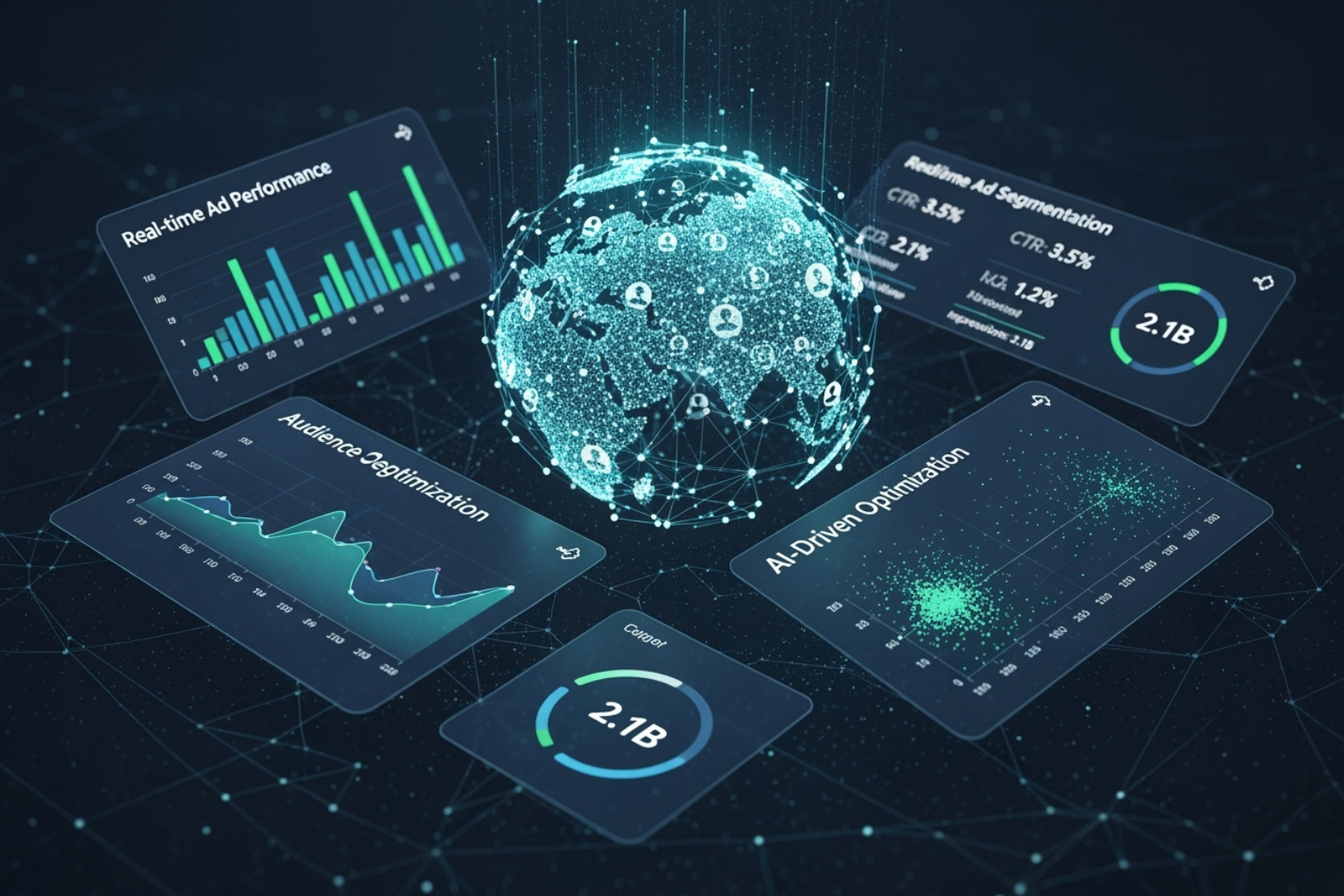Why Digital Ad Management Is the Key to Business Growth
Digital ad management is the process of planning, creating, launching, and improving your online ad campaigns to reach target customers and grow your business. It involves a cycle of strategy, creation, platform management, performance monitoring, and making data-driven adjustments to get better results.
Running effective digital ads means reaching customers who are actively looking for what you offer. This is a powerful way to connect with interested buyers. Businesses that get good at this see impressive results, like generating more leads and lowering ad costs. However, many businesses struggle with common problems like poor planning and budget issues. The good news is these problems are solvable with the right approach.
Why Digital Ad Management Matters for Your Business:
- Precise Targeting: Reach customers based on interests, behaviors, and searches.
- Reliable Tracking: Know which ads drive sales and which don't.
- Budget Control: Set spending limits and adjust them in real-time.
- Scalability: Do more of what works and cut what doesn't.
I'm Steve Pogson, founder of First Pier, and I've spent over two decades helping businesses like yours use digital ad management to drive lasting growth. My team and I have created effective strategies for all major ad platforms, turning ad spend into predictable revenue.

Important digital ad management terms:
- how to optimize digital marketing campaigns
- digital marketing tools
- how to measure the effectiveness of a digital marketing campaign
Getting Started: The Core of Digital Ad Management
This section explains the basics of managing your online ads, setting you up for success from the start.
What is Digital Ad Management and Why Does It Matter?
At its heart, digital ad management is about overseeing your online ad campaigns to make sure they are effective. It's not just about placing ads; it's about ensuring every dollar you spend works hard for your business by reaching your target customers.
This is important because digital advertising lets you find people who are already searching for what you sell. Unlike traditional advertising, you can pinpoint your ideal customer with great accuracy. This means less wasted ad spend and more meaningful results.
Good digital ad management also gives you a clear view of your performance and control over your budget. You can see which ads are working, what they cost, and how they help sales. This clarity helps you do more of what's working and stop what isn't, which is key for e-commerce businesses on platforms like Shopify to attract interested visitors and improve their bottom line.
More info about paid search services
The Key Parts of a Strong Ad Management Strategy
Successful digital ad campaigns are built on a few core pieces:
First is your Strategy. This is your game plan. Before creating an ad, set clear goals (more sales, more leads?) and identify your ideal customer. A solid strategy ensures every ad has a purpose.
Next is Creative. This is how your ads come to life with eye-catching images and words that connect with your audience. Your creative needs to grab attention and get people to act.
Then comes Campaign Management. This is the daily work of running your ads on platforms like Google, Meta, and LinkedIn. It involves setting up ads, managing bids, and making sure everything runs smoothly.
A vital step is Testing. You won't know what works best until you test different ad messages, images, and audiences. This gives you real data on what gets the best results.
Last is Reporting. This means tracking key numbers to understand how your campaigns are performing. Clear reports help you see if your money is well spent and direct your next steps.
Our team has a proven process for building, launching, and growing campaigns on Google, Facebook, and LinkedIn, making sure your ad efforts line up with your business goals.
More info about marketing campaign strategy
Overcoming Common Ad Problems
Every advertiser runs into challenges. It's like trying to find your way in a new city without a map—you might get there, but it will be harder and take longer.

I've seen businesses struggle with these common ad management problems:
- Lack of planning: Campaigns launched without clear goals often miss the mark.
- Time constraints: Managing multiple campaigns is time-consuming.
- Budget inefficiencies: Wasting money on ads that don't perform well.
- Lack of expertise: Keeping up with the latest strategies is overwhelming.
- Difficulty scaling ads: Not knowing how to grow ad spend effectively.
It typically takes about 90 days to see if there's potential for predictable growth in an ad account. This initial period is for setting the foundation and finding what works.
How to Solve Common Ad Management Problems
The good news is that these challenges are solvable. Here’s how I approach them:
- A Clear Strategy is Your Compass: To fix a lack of planning, define clear, measurable goals. Identify your target audience by understanding their demographics and interests. A consistent ad style and schedule will give you more say over your campaign's performance.
- Automation Tools are Your Allies: To save time, use automation. These tools can handle repetitive tasks like performance monitoring and budget adjustments, freeing you to focus on strategy and creative work.
- Partner with Experts or Invest in Learning: If a lack of expertise is holding you back, think about partnering with an ad agency. They bring fresh perspectives and can help your team learn more. Investing in online courses and industry resources is also a smart move.
- Optimize Your Budget Smartly: Fix inefficient spending by choosing the right budget and bids for your goals. Continuous monitoring and testing are essential. For example, on Shopify, you'll want to track your cost per click (CPC) and conversion rates to ensure you're getting a good return.
- Scale Gradually and Experiment: To scale, start with a solid foundation. Review successful campaigns to understand why they worked. Then, slowly raise your ad budget by 15-20% every few days while watching performance. Experiment with new targeting options and audience segments, and don't be afraid to explore new platforms to reach more people.
More info about paid social media ads
Tools and Tech: Your Ad Management Toolkit
Managing ad campaigns today without the right tools is impractical and slow. Technology plays a big part in making your life easier and your ads more effective. Let's look at the tools that can help you manage your campaigns like a pro.
The Role of Technology in Modern Digital Ad Management

Technology, especially automation, has changed digital ad management. Smart systems now do a lot of the heavy lifting for you.
These tools are a huge time-saver. They handle repetitive tasks, freeing up your team to focus on bigger ideas. This automation for efficiency is key. From setting up campaigns to improving ad bids, automation makes ad management smoother, with fewer errors and more consistent performance.
AI and machine learning act as your smart assistants. These technologies are changing how we make digital advertising better. Google, for instance, uses AI-powered ad solutions to help businesses find new customers and create ad content. These smart systems can analyze huge amounts of data, predict outcomes, and automate bidding to make sure your money is used effectively.
With bidding optimization, AI takes the guesswork out of ad spending. Algorithms can adjust bids in real-time based on your goals, helping you get the best value. For Shopify businesses, using automation tools can be a game-changer, allowing campaigns to run smoothly and adapt to market changes without constant manual work.
Learn the essentials of AI-powered ad solutions
More info about Shopify automation
Choosing the Right Ad Management Software
With so many tools out there, how do you pick the right one? You need one that fits your needs and is easy to use. Here's what I look for:
First, user-friendliness is most important. A simple layout makes it easy to direct and manage campaigns. Next, CRM integration is vital for a complete picture of your marketing efforts.
If you run ads on many platforms, a tool with cross-channel management is very helpful, letting you manage everything from one place. Strong reporting features are also non-negotiable for making smart choices.
As mentioned, automation is a lifesaver. Look for tools that can do repetitive tasks for you. Many now offer AI-powered features for creating ads and handling bids, which can make your ads much more effective. Good tools also help you identify and reach your ideal audience. If you have a team, features that help with teamwork, like shared dashboards, are very useful.
Using specialized digital ad management platforms makes advertising easier and more automatic. They help you get more done and increase the likelihood of your campaigns succeeding.
Here are some key features to look for in ad management software:
- Centralized dashboard for all platforms
- Automated bidding and budget improving
- A/B testing abilities
- Reporting and analytics you can adjust
- Audience finding and targeting tools
- Creative management and dynamic ad creation
- Connection with CRM and other marketing tools
- AI-powered insights and suggestions
- Teamwork and workflow management
- Real-time performance watching
Building and Optimizing High-Performing Campaigns
This is your playbook for creating ads that work, measuring their success, and growing your business.
A Step-by-Step Guide to Effective Campaign Creation
Making ads that get results requires a clear plan. Think of it like baking a cake—you need the right steps and ingredients.

Here's a simple breakdown:
First, define your goals. What do you want to achieve? More brand awareness, new leads, or direct sales? Your goals will shape every choice you make.
Next is audience targeting. Figure out who your ideal customers are based on their interests, location, and habits. This ensures your ads are seen by the right people.
Then comes your creative and messaging. Use eye-catching images and videos with clear, short messages that speak to your audience's needs.
Finally, always remember A/B testing. Don't just guess what works. Test different headlines, images, and calls to action to see what performs best. This data-driven approach helps make your ads more effective over time.
Reach more of your ideal customers with custom audiences
More info about collateral design
Best Practices for Top Ad Platforms
Each ad platform has its own strengths. Here’s a quick look at the big ones:
- Google Ads: Excellent for reaching people actively searching for products or answers. Performance Max campaigns use AI to find customers across all of Google’s channels. For e-commerce, Shopping Ads are a must.
- Meta Ads (Facebook & Instagram): Great for finding people based on their interests and demographics. High-quality images and videos are key here, as these are visual platforms. Retargeting people who have visited your site is also very effective.
- LinkedIn Ads: Perfect for B2B marketing. You can target users by job title or industry, and Lead Gen Forms make it easy to collect information from potential customers.
- Spotify Ads: A unique place to reach an involved audience through audio and video. Ads here can reach users at just the right moment, leading to better brand recall.
The key is to understand each platform's audience and tailor your strategy accordingly.
Choose the right campaign for your business
Using Data to Measure, Optimize, and Scale Your Ads
Once your ads are running, the real work begins: checking performance, making improvements, and growing your campaigns.
The first step is measuring ROI (Return on Investment). You need to know how much you're getting back for every dollar spent. Track key metrics like Cost Per Acquisition (CPA) and Return on Ad Spend (ROAS).
You also need to be tracking conversions. Whether it's a sale or a form submission, tracking these actions tells you what's working and helps you make better decisions.
Making data-driven decisions means constantly watching your campaign analytics. This lets you move your budget from ads that aren't performing well to the ones that are.
When a campaign is doing well, you’ll want to scale gradually. Slowly raise your ad budget, perhaps by 15-20% every few days, to maintain control and monitor performance. Exploring new platforms can also help you reach new audiences.
Good digital ad management is a continuous loop: plan, launch, check, learn, and make things better. It’s about letting the numbers direct your choices.
More info about ecommerce analytics
The Future of Digital Advertising
The world of advertising is always changing, and to stay ahead, you need to keep an eye on what’s next. These trends are going to shape how we manage ads in the coming years.

AI is the path forward for digital ad management. We already see AI-powered tools that help make ads better, develop new visuals, and handle smart bidding. Generative AI is setting a new standard for e-commerce with personalized shopping experiences and content creation. AI will continue to make ad campaigns smoother and more effective.
Next is Programmatic Advertising. This is an automated way to buy ad space, allowing your ads to reach specific people very effectively, even on a large scale. As AI improves, this type of ad buying will become more advanced, ensuring your ads reach the right person at the right time.
Then there are Privacy Changes. With rules like GDPR and CCPA, how we gather and use customer data is changing. Advertisers will need to adopt a privacy-first approach. This may mean using first-party data (data you collect directly) or contextual targeting (showing ads based on page content, not personal data).
Look out for more Interactive Ads. These ads invite people to play or participate directly, which can boost involvement and brand recall.
Finally, consider the "Dark Funnel." This refers to the parts of a customer's experience we can't easily track, like private chats or word-of-mouth recommendations. Future digital ad management will need to find smarter ways to understand these hidden interactions, perhaps by focusing on brand building and community.
Being quick to adapt to these changes will be important for keeping your digital ad management successful.
To Sum Up
So, what's the big takeaway about digital ad management? It's not a "set it and forget it" task. Think of it more like gardening—you plant the seeds, but then you have to water, weed, and prune to help everything grow. It's a continuous cycle of planning, testing, and fine-tuning.
If you follow the steps we've talked about—from smart planning to testing and using helpful tech—you'll be able to sidestep common ad problems and build campaigns that truly make your business grow.
For e-commerce businesses, getting good at this means you'll connect with more people who are ready to click "buy." That translates directly into more sales and better revenue.
Now, I know this might sound like a lot to handle on your own. If you ever feel you need a friendly team of experts to help direct your strategy, we at First Pier are here for you. We love helping businesses like yours develop and manage ad campaigns that get real results.







